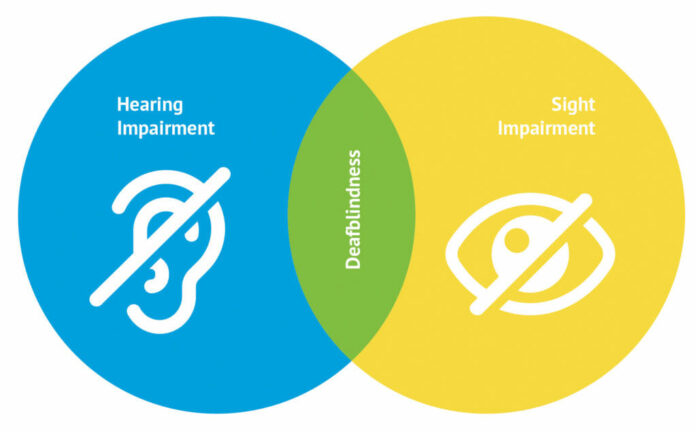A complicated hearing and vision impairment, deafblindness can be brought on by illnesses, injuries, hereditary conditions, ageing, or other circumstances. Deafblindness, a prevalent condition that primarily affects the elderly, is a combination of hearing loss and vision loss that impairs speech and hearing.
This type of hearing or vision loss, or both, happens later in life and is often referred to as dual sensory loss or multi-sensory impairment. Nevertheless, some newborns are born deafblind. As is well known, hearing and vision are the two main senses that humans use for communication. These two senses work in concert to improve one another’s functionality. A deafblind individual does not, however, suddenly become deaf and blind. The majority of the time, one sense makes up for the other, and hearing and vision loss can occasionally be extremely minimal. The patient might not even be aware that their hearing or eyesight are being impacted at first. Premature delivery, prenatal infection, age-related changes, and hereditary factors are among the causes of this illness. This disease, which affects people of all ages, is mostly thought to have hereditary roots. A reduction in both senses leads to serious problems in day-to-day living.
Deafblindness Types
Those that are deafblind fall into two main categories:
Birth-related Deafblindness
Certain defects are inherited by humans from birth. They can be inherited or brought on by external circumstances. They are sometimes referred to as congenital abnormalities, congenital diseases, or congenital deformities. Individuals who have congenital deafblindness are either born deafblind, or they develop other forms of language and communication before speaking, or they have hearing and vision impairments prior to speaking. Congenital deafblindness can result from a variety of causes, including an infection the mother received while pregnant, a condition, or an injury that may have an impact on the child’s development.
Children that suffer from this issue also develop mental retardation or cerebral palsy. Congenital deafblindness can occasionally be misdiagnosed due to the rarity of certain genetic disorders and evaluation challenges. There are currently up to twenty distinct genetic disorders known to be linked to this illness.
Developmental Deafblindness
After some time, those who are born deaf begin to lose their sight. Usher Syndrome, which results in birth deafness and later visual impairment, is a typical case. It can occur occasionally as a result of an illness, accident, or injury. In addition, some individuals age blind or deaf, while still others lose both eyesight and hearing.
Resulting from Deafblindness
Life with deafblindness is not easy. It impairs a person’s capacity for social interaction, communication, and information gathering. Patients experience emotions of loneliness and low self-worth as a result of losing the self-assurance necessary to move alone and perform daily chores. A person’s emotional health is greatly impacted by whether they were born deafblind or developed vision and hearing loss as a result of sensory degeneration later in life.
Assessment
In the last few years, significant advances in the understanding of genetics, sophisticated diagnostic instruments for the evaluation of vision and hearing, and proper screening have all been made. Each of these helps ensure an accurate and timely diagnosis. Before vision and hearing loss are deemed positive, tests of the heart, lungs, brain, blood, immunological and digestive systems, muscles, and movement are performed. An accurate prognosis can be given more often with an early diagnosis, which facilitates better rehabilitation and care.
Managing Deafblindness
The main goal of treatment is to lessen patients’ isolation and assist them in leading stress-free lives, as there is no chance of a full recovery from the disorder. Although there are currently no visual implants available, various studies on the implantation of electrodes and cameras in the retina have produced encouraging results. There are ways to enhance useful speech comprehension. Cochlear implantation is a helpful device for improving hearing. A cochlear implant is a tiny, cutting-edge electronic gadget that helps those who are profoundly deaf or have inner ear hearing loss perceive sound. A common alternative is a hearing aid, which amplifies sounds that the damaged ear detects. Cochlear implants, on the other hand, bypass the damaged ear and stimulate the auditory nerve directly. Combining a cochlear implant and hearing aid can be very beneficial for a person. Above all, communication with the rest of the community and other deafblind individuals has been made easier thanks to the internet. Using computers is also recommended to help patients communicate better through speech and braille and to lessen their isolation.
In addition to the potential use of stem cells, medications or growth hormones are being attempted and investigated as preventative measures for progressive hearing and vision loss. Worldwide, extensive research is being conducted on the regeneration of retinal nerve cells. In the near future, medical and genetic treatments may result from pinpointing the specific mutation causing genetic illnesses.




























